User:SomeGuyWhoRandomlyEdits/Ubaid period
A clickable map of Iraq detailing important sites that were occupied during the Ubaid period. | |
| Geographical range | Near East |
|---|---|
| Period | Neolithic |
| Dates | c. 5500 – c. 3700 BC |
| Type site | Tell al-'Ubaid |
| Major sites | |
| Preceded by | |
| Followed by | |
| History of Iraq |
|---|
 |
|
|
| The Neolithic |
|---|
| ↑ Mesolithic |
| ↓ Chalcolithic |
The Ubaid period (c. 5500–3700 BC)[1] is a prehistoric period of Mesopotamia. The name derives from Tell al-'Ubaid where the earliest large excavation of Ubaid period material was conducted initially in 1919 by Henry Hall and later by Leonard Woolley.[2]
In South Mesopotamia the period is the earliest known period on the alluvial plain although it is likely earlier periods exist obscured under the alluvium.[3] In the south it has a very long duration between about 5500 and 3800 BC when it is replaced by the Uruk period.[1]
In Northern Mesopotamia the period runs only between about 5300 and 4300 BC.[1] It is preceded by the Halaf period and the Halaf-Ubaid Transitional period and succeeded by the Late Chalcolithic period.
History of research
[edit]The term "Ubaid period" was coined at a conference in Baghdad in 1930, where at the same time the Jemdet Nasr and Uruk periods were defined.[4]
Dating, extent and periodization
[edit]The Ubaid period is divided into six phases, styles, and/or periods:
- Ubaid 0 (alternatively: the Oueili style; c. 6500 – c. 5400 BC) is an Early Ubaid style first excavated at Tell el-'Oueili.[5][6]
- Ubaid 1 (alternatively: the Ubaid I, Early Ubaid, or Eridu style; c. 5400 – c. 4700 BC) is a style centered at Tell Abu Shahrain and limited to southern Iraq—on what was then the shores of the Persian gulf. This style—showing clear connection to the Samarra culture to the north—saw the establishment of the first permanent settlement south of the five-inch rainfall isohyet. These people pioneered the growing of grains in the extreme conditions of aridity; thanks to the high water tables of southern Iraq.[7][5][6]
- Ubaid 2 (alternatively: the Ubaid II or Hadji Muhammed style; c. 4800 – c. 4500 BC) is the style centered at Hadji Muhammed that saw the development of extensive canal networks from major settlements. Irrigation agriculture (which seems to have developed first at Choga Mami and rapidly spread elsewhere) was pioneered by farmers who may have also brought with them elements of the Samarran culture from the first required collective effort and centralized coordination of labor.[8][5][6]
- Ubaid 3 (alternatively: the Ubaid III style; c. 5300 – c. 4700 BC) ceramics have been discovered at the type site for which the period is named after: Tell al-'Ubaid. The appearance of these ceramics received different dates depending on the particular archaeological sites, which have a wide geographical distribution. In recent studies; there's a tendency to narrow this period somewhat.[5][6]
- Ubaid 4 (alternatively: the Ubaid IV or Late Ubaid style; c. 4700 – c. 4200 BC)[5][9][6][10]
- Ubaid 5 (alternatively: the Ubaid V or Terminal Ubaid style; c. 4200 – c. 3800 BC)[6]
Ubaid 0-1
[edit]-
Ubaid 0-1; pottery; Godin Tepe; Oriental Institute Museum
-
Ubaid 0-1; footed bowl; Godin Tepe; Oriental Institute Museum
Ubaid 2
[edit]-
Ubaid 2; pottery; Oriental Institute Museum
-
Northern Ubaid; pottery; Tepe Gawra; Oriental Institute Museum
Ubaid 3
[edit]-
Ubaid III; campaniform pottery; c. 5300 – c. 4700 BC; Louvre Museum AO 29598
-
Ubaid 3-4; pottery; Oriental Institute Museum
-
Ubaid 3-4; a sickle and bent nail; clay; Oriental Institute Museum
Ubaid 4
[edit]Ubaid 5
[edit]Influence to the north
[edit]This section needs additional citations for verification. (May 2022) |

Around 5000 BC, the Ubaid culture spread into northern Mesopotamia and was adopted by the Halaf culture.[18][19] This is known as the Halaf-Ubaid Transitional period of northern Mesopotamia.
During the late Ubaid period around 4500–4000 BC, there was some increase in social polarization, with central houses in the settlements becoming bigger. But there were no real cities until the later Uruk period.
Ubaid influence in the Persian Gulf area
[edit]During the Ubaid 2 and 3 periods (5500–5000 BC), southern Mesopotamian Ubaid influence is felt further to the south along the coast of the Persian Gulf. Kuwait was the central site of interaction between the peoples of Mesopotamia and Neolithic Eastern Arabia,[20][21][22][23][24] including Bahra 1 and site H3 in Subiya.[20][25][26][27] Ubaid artifacts spread also all along the Arabian littoral, showing the growth of a trading system that stretched from the Mediterranean coast through to Oman.[28][29]
Spreading from Eridu, the Ubaid culture extended from the Middle of the Tigris and Euphrates to the shores of the Persian Gulf, and then spread down past Bahrain to the copper deposits at Oman.
Obsidian trade
[edit]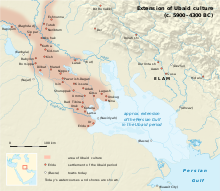
Starting around 5500 BC, Ubaid pottery of periods 2 and 3 has been documented at site H3 in Kuwait and in Dosariyah in eastern Saudi Arabia.
In Dosariyah, nine samples of Ubaid-associated obsidian were analyzed. They came from eastern and northeastern Anatolia, such as from Pasinler, Erzurum, as well as from Armenia. The obsidian was in the form of finished blade fragments.[30]
Decline of influence
[edit]The archaeological record shows that Arabian Bifacial/Ubaid period came to an abrupt end in eastern Arabia and the Oman peninsula at 3800 BC, just after the phase of lake lowering and onset of dune reactivation.[31] At this time, increased aridity led to an end in semi-desert nomadism, and there is no evidence of human presence in the area for approximately 1,000 years, the so-called "Dark Millennium".[32] The increased aridity might have been due to the 5.9 kiloyear event at the end of the Older Peron.[31]
Numerous examples of Ubaid pottery have been found along the Persian Gulf, as far as Dilmun, where Indus Valley civilization pottery has also been found.[33]
Description
[edit]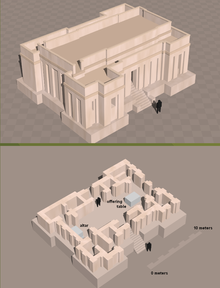
Ubaid culture is characterized by large unwalled village settlements, multi-roomed rectangular mud-brick houses and the appearance of the first temples of public architecture in Mesopotamia, with a growth of a two tier settlement hierarchy of centralized large sites of more than 10 hectares surrounded by smaller village sites of less than 1 hectare. Domestic equipment included a distinctive fine quality buff or greenish colored pottery decorated with geometric designs in brown or black paint. Tools such as sickles were often made of hard fired clay in the south, while in the north stone and sometimes metal were used. Villages thus contained specialised craftspeople, potters, weavers and metalworkers, although the bulk of the population were agricultural labourers, farmers and seasonal pastoralists.
During the Ubaid Period (5000–4000 BC), the movement towards urbanization began. "Agriculture and animal husbandry [domestication] were widely practiced in sedentary communities".[34] There were also tribes that practiced domesticating animals as far north as Turkey, and as far south as the Zagros Mountains.[34] The Ubaid period in the south was associated with intensive irrigated hydraulic agriculture, and the use of the plough, both introduced from the north, possibly through the earlier Choga Mami, Hadji Muhammed and Samarra cultures.
-
Bowl; mid 6th–5th millennium BC; ceramic; 6.99 cm; Tell Abu Shahrain; Metropolitan Museum of Art
-
Bowl; mid 6th–5th millennium BC; ceramic; Tell Abu Shahrain; Metropolitan Museum of Art
-
Bowl; mid 6th–5th millennium BC; ceramic; 5.08 cm; Tell Abu Shahrain; Metropolitan Museum of Art
-
Cup; mid 6th–5th millennium BC; ceramic; 8.56 cm; Tell Abu Shahrain; Metropolitan Museum of Art
-
Cup; mid 6th–5th millennium BC; ceramic; 9.53 cm; Tell Abu Shahrain; Metropolitan Museum of Art
-
Jar; mid 6th–5th millennium BC; ceramic; 15.24 cm; Tell Abu Shahrain; Metropolitan Museum of Art
-
Pottery bowl with a rounded bottom and monochrome paint (rosettes); c. 5000 BC; Telul eth-Thalathat; Iraq Museum
-
Late Ubaid; shallow dish decorated with geometric designs in dark paint; c. 5200 – c. 4200 BC; Tell al-'Ubaid; British Museum
-
Late Ubaid; spouted jar decorated with geometric designs in dark paint; c. 5200 – c. 4200 BC; Tell el-Muqayyar; British Museum
-
Late Ubaid; painted bowl, decorated with geometric designs in dark paint; c. 5200 – c. 4200 BC; Tell el-Muqayyar; British Museum
-
Late Ubaid; painted cup, decorated with geometric designs in dark paint tattoos; c. 5200 – c. 4200 BC
-
Late Ubaid; figurine of a lizard-headed nude woman nursing a child; terracotta and bitumen; c. 4000 BC; Iraq Museum
-
Figurine of a woman feeding a child and decorated to show jewellery or tattoos; clay; c. 5200 – c. 4200 BC; Tell el-Muqayyar
-
Female figurine; clay; c. 5200 – c. 4200 BC; Tell el-Muqayyar
-
Goblet and cup; c. 4000 BC; Susa; Sèvres – Cité de la céramique museum
-
Late Ubaid; pottery jar; Southern Iraq; Museum of Fine Arts, Boston
Society
[edit]This section needs additional citations for verification. (May 2022) |

The Ubaid period as a whole, based upon the analysis of grave goods, was one of increasingly polarized social stratification and decreasing egalitarianism. Bogucki describes this as a phase of "Trans-egalitarian" competitive households, in which some fall behind as a result of downward social mobility. Morton Fried and Elman Service have hypothesised that Ubaid culture saw the rise of an elite class of hereditary chieftains, perhaps heads of kin groups linked in some way to the administration of the temple shrines and their granaries, responsible for mediating intra-group conflict and maintaining social order. It would seem that various collective methods, perhaps instances of what Thorkild Jacobsen called primitive democracy, in which disputes were previously resolved through a council of one's peers, were no longer sufficient for the needs of the local community.
Ubaid culture originated in the south, but still has clear connections to earlier cultures in the region of middle Iraq. The appearance of the Ubaid folk has sometimes been linked to the so-called Sumerian problem, related to the origins of Sumerian civilisation. Whatever the ethnic origins of this group, this culture saw for the first time a clear tripartite social division between intensive subsistence peasant farmers, with crops and animals coming from the north, tent-dwelling nomadic pastoralists dependent upon their herds, and hunter-fisher folk of the Arabian littoral, living in reed huts.
Stein and Özbal describe the Near East oecumene that resulted from Ubaid expansion, contrasting it to the colonial expansionism of the later Uruk period. "A contextual analysis comparing different regions shows that the Ubaid expansion took place largely through the peaceful spread of an ideology, leading to the formation of numerous new indigenous identities that appropriated and transformed superficial elements of Ubaid material culture into locally distinct expressions."[35]
The earliest evidence for sailing has been found in Kuwait indicating that sailing was known by the Ubaid 3 period.[9]
There is some evidence of warfare during the Ubaid period although it is extremely rare. The "Burnt Village" at Tell Sabi Abyad could be suggestive of destruction during war but it could also have been due to other causes, such as wildfire or accident. Ritual burning is also possible since the bodies inside were already dead by the time they were burned. A mass grave at Tepe Gawra contained 24 bodies apparently buried without any funeral rituals, possibly indicating it was a mass grave from violence. Copper weapons were also present in the form of arrow heads and sling bullets, although these could have been used for other purpose; two clay pots recovered from the era have decorations showing arrows used for the purpose of hunting. A copper axe head was made in the late Ubaid period, which could have been a tool or a weapon.[36]
-
Stamp seal and modern impression: horned animal and bird; 6th–5th millennium
-
Late Ubaid–Middle Gawra; drop-shaped (tanged) pendant seal and modern impression with quadrupeds, not entirely reduced to geometric shapes; c. 4500 – c. 3500 BC; Northern Mesopotamia; Metropolitan Museum of Art
See also
[edit]Citations
[edit]- ^ Hall & Woolley 1927.
- ^ Adams Jr. & Wright 1989.
- ^ Matthews 2002, pp. 1–7.
- ^ a b c d e Kuhrt 1995, p. 22.
- ^ Roux 1966.
- ^ Wittfogel 2010.
- ^ a b Carter 2006b.
- ^ Ashkanani et al. 2019.
- ^ Raux 1989d.
- ^ Raux 1989a.
- ^ Raux 1989c.
- ^ Raux 1932d.
- ^ Raux 1931.
- ^ Raux 1932a.
- ^ Raux 1932b.
- ^ Pollock & Bernbeck 2009, p. 190.
- ^ Akkermans 2003, p. 157.
- ^ a b Carter, Robert (2019). "The Mesopotamian frontier of the Arabian Neolithic: A cultural borderland of the sixth–fifth millennia BC". Arabian Archaeology and Epigraphy. 31 (1): 69–85. doi:10.1111/aae.12145.
- ^ Carter, Robert (25 October 2010). Maritime Interactions in the Arabian Neolithic: The Evidence from H3, As-Sabiyah, an Ubaid-Related Site in Kuwait. BRILL. ISBN 9789004163591.
- ^ Carter, Robert. "Boat remains and maritime trade in the Persian Gulf during the sixth and fifth millennia BC" (PDF).
- ^ Carter, Robert. "Maritime Interactions in the Arabian Neolithic: The Evidence from H3, As-Sabiyah, an Ubaid-Related Site in Kuwait".
- ^ "How Kuwaitis lived more than 8,000 years ago". Kuwait Times. 2014-11-25.
- ^ Carter, Robert (2002). "Ubaid-period boat remains from As-Sabiyah: excavations by the British Archaeological Expedition to Kuwait". Proceedings of the Seminar for Arabian Studies. 32: 13–30. JSTOR 41223721.
- ^ Carter, Robert; Philip, Graham. "Beyond the Ubaid: Transformation and integration in the late prehistoric societies of the Middle East" (PDF).
- ^ "PAM 22". pcma.uw.edu.pl.
- ^ Bibby 2008.
- ^ Crawford 1998.
- ^ Khalidi & Gratuze 2016.
- ^ a b Parker et al. 2017.
- ^ Uerpmann 2003, pp. 74–81.
- ^ Stiebing Jr. 2016, p. 85.
- ^ a b Pollock 1999.
- ^ Stein & Özbal 2006.
- ^ Hamblin, William J. (2006). Warfare in the ancient Near East to 1600 BC: Holy warriors at the dawn of history. Routledge. p. 28-29.
- ^ Raux 1932c.
- ^ Charvát 2002, p. 96.
- ^ Brown & Feldman 2013, p. 304.
References
[edit]- Adams Jr., Robert McCormick; Wright, Henry Tutwiler (1989). Henrickson, Elizabeth F.; Thuesen, Ingolf (eds.). Upon this Foundation: The ʻUbaid Reconsidered : Proceedings from the ʻUbaid Symposium, Elsinore, May 30th-June 1st 1988. Museum Tusculanum Press. ISBN 9788772890708.
- Akkermans, Peter M. M. G. (2003). The Archaeology of Syria: From Complex Hunter-Gatherers to Early Urban Societies (c.16,000-300 BC). Cambridge University Press. ISBN 9780521796668.
- Ashkanani, Hasan J.; Tykot, Robert H.; Al-Juboury, Ali Ismail; Stremtan, Ciprian C. (2019-11-24). "A characterisation study of Ubaid period ceramics from As‐Sabbiya, Kuwait, using a non‐destructive portable X‐Ray fluorescence (pXRF) spectrometer and petrographic analyses". Arabian Archaeology and Epigraphy. 31 (8). Petřík, Jan; Slavíček, Karel. doi:10.1111/aae.12143.
- Bibby, Thomas Geoffrey (2008-08-27). Looking for Dilmun. United Kingdom: Knopf. ISBN 9780394434001.
- Bogucki, Peter (1990). The Origins of Human Society. Malden, MA: Blackwell. ISBN 1577181123.
- Brown, Brian A.; Feldman, Marian H. (2013). Critical Approaches to Ancient Near Eastern Art. Walter de Gruyter. ISBN 9781614510352.
- Carter, Robert (2006-04-20). Philip, G. (ed.). Beyond the Ubaid: Transformation and Integration in the Late Prehistoric Societies of the Middle East. United Kingdom: Oriental Institute of the University of Chicago. ISBN 9781885923660.
- Carter, Robert (March 2006). Carver, Martin (ed.). "Boat remains and maritime trade in the Persian Gulf during the sixth and fifth millennia BC". Antiquity. 80 (307): 52–63. doi:10.1017/S0003598X0009325X.
{{cite journal}}: CS1 maint: date and year (link) - Crawford, Harriet Elizabeth Walston (1998-03-12). Dilmun and Its Gulf Neighbours. United Kingdom: Cambridge University Press. ISBN 9780521586795.
- Crawford, Harriet Elizabeth Walston (2004-09-16). Sumer and the Sumerians. United Kingdom of Great Britain and Northern Ireland: Cambridge University Press (CUP). ISBN 9780521533386.
- Hall, Harry Reginald; Woolley, Charles Leonard (1927). Al-'Ubaid: A Report on the Work Carried Out at Al-'Ubaid for the British Museum in 1919 and for the Joint Expedition in 1922-3. ASIN B00086M1HG.
- Hamblin, William J. (2006-09-27). Warfare in the Ancient Near East to 1600 BC: Holy Warriors at the Dawn of History. Routledge. ISBN 9781134520626.
- Khalidi, Lamya; Gratuze, Bernard (2016-10-18). "The growth of early social networks: New geochemical results of obsidian from the Ubaid to Chalcolithic Period in Syria, Iraq and the Gulf". Journal of Archaeological Science. 9. Elsevier: 743–757. doi:10.1016/j.jasrep.2016.06.026.
- Kuhrt, Amélie (1995). The Ancient Near East, C. 3000-330 BC. Routledge history of the ancient world. Vol. 1. Taylor & Francis. ISBN 9780415167635.
- Matthews, Roger (2002). Secrets of the Dark Mound: Jemdet Nasr 1926-1928 (Report). Iraq archaeological reports. Vol. 6. Warminster: BISI. ISBN 9780856687358. ISSN 0956-2907.
- Parker, Adrian G.; Goudie, Andrew S.; Stokes, Stephen; White, Kevin; Hodson, Martin J.; Manning, Michelle; Kennet, Derek (2017-01-20). "A record of Holocene climate change from lake geochemical analyses in southeastern Arabia" (PDF). Quaternary Research. 66 (3). Elsevier: 465–476. Bibcode:2006QuRes..66..465P. doi:10.1016/j.yqres.2006.07.001.
- Pollock, Susan (1999-05-20). Wright, Rita P. (ed.). Ancient Mesopotamia. Case Studies in Early Societies. Vol. 1. Cambridge University Press. ISBN 9780521575683.
- Pollock, Susan; Bernbeck, Reinhard (2009-02-09). Archaeologies of the Middle East: Critical Perspectives. Penton. ISBN 9781405137232.
- Raux, Franck (1931). "AO 14281". Département des Antiquités orientales. Musée du Louvre (in French). SALLE 236.
{{cite web}}: CS1 maint: location (link) - Raux, Franck (1932a). "AO 15327". Département des Antiquités orientales. Musée du Louvre (in French). SALLE 236. Archived from the original on 2015-04-15.
{{cite web}}: CS1 maint: location (link) - Raux, Franck (1932d). "AO 15334". Département des Antiquités orientales. Musée du Louvre (in French). SALLE 236.
{{cite web}}: CS1 maint: location (link) - Raux, Franck (1932b). "AO 15338". Département des Antiquités orientales. Musée du Louvre (in French). SALLE 236.
{{cite web}}: CS1 maint: location (link) - Raux, Franck (1932c). "AO 15388". Département des Antiquités orientales. Musée du Louvre (in French). SALLE 236.
{{cite web}}: CS1 maint: location (link) - Raux, Franck (1989a). "AO 29598". Département des Antiquités orientales. Musée du Louvre (in French). SALLE 236. Archived from the original on 2021-09-15.
{{cite web}}: CS1 maint: location (link) - Raux, Franck (1989d). "AO 29611". Département des Antiquités orientales. Musée du Louvre (in French). SALLE 236. Archived from the original on 2021-09-15.
{{cite web}}: CS1 maint: location (link) - Raux, Franck (1989c). "AO 29616". Département des Antiquités orientales. Musée du Louvre (in French). SALLE 236. Archived from the original on 2021-06-22.
{{cite web}}: CS1 maint: location (link) - Roux, Georges (1966). Ancient Iraq. Penguin Books. ISBN 9780140125238.
- Stiebing Jr., William H. (2016-07-01). Ancient Near Eastern History and Culture. MySearchLab Series (revised ed.). Longman. ISBN 9781315511160.
- Stein, Gil; Özbal, Rana (2006). "A Tale of Two Oikumenai: Variation in the Expansionary Dynamics of Ubaid and Uruk Mesopotamia". In Stone, Elizabeth C. (ed.). Settlement and Society: Ecology, urbanism, trade and technology in Mesopotamia and Beyond. Santa Fe, New Mexico: School for Advanced Research Press. pp. 329–343.
- Uerpmann, Margarethe (2003). "The Dark Millennium—Remarks on the final Stone Age in the Emirates and Oman". In Potts, Daniel T.; Al Naboodah, Hasan; Hellyer, Peter (eds.). Archaeology of the United Arab Emirates. Proceedings of the First International Conference on the Archaeology of the U.A.E. United Kingdom: Trident Press. ISBN 9781900724982.
- Wittfogel, Karl August (2010-09-07). Oriental Despotism: A Comparative Study of Total Power. Oriental Despotism: A Comparative Study of Total Power. United Kingdom: Yale University Press. ISBN 9780835782562.
Further reading
[edit]- Charvát, Petr (2002). Mesopotamia Before History (revised ed.). Routledge. ISBN 9781134530779.
- Martin, Harriet P. (1982). "The Early Dynastic Cemetery at al-'Ubaid, a Re-Evaluation". Iraq. 44 (2): 145–185. doi:10.2307/4200161. JSTOR 4200161.
- Mellaart, James (1975). The Neolithic of the Near East. New York: Scribner. ISBN 0684144832.
- Moore, A. M. T. (2002). "Pottery Kiln Sites at al 'Ubaid and Eridu". Iraq. 64: 69–77. doi:10.2307/4200519. JSTOR 4200519.
- Nissen, Hans Jörg (1990). The Early History of the Ancient Near East, 9000–2000 B.C.. Chicago: University of Chicago Press. ISBN 0226586588.
External links
[edit]- British Museum, Trustees of the (2008-06-03). "Stone statue of Kurlil". The British Museum. Archived from the original on 2015-10-18.
- British Museum, Trustees of the (2007-11-13). "Copper figure of a bull". The British Museum. Archived from the original on 2007-11-13.
- British Museum, Trustees of the (2008-06-06). "Ubaid visit and photos". The British Museum. Archived from the original on 2008-08-01.






![Ubaid III; jar; c. 5300 – c. 4700 BC; Louvre Museum AO 29611[11]](http://upload.wikimedia.org/wikipedia/commons/thumb/0/00/Ubaid_III_pottery_jar_5300-4700_BC_Louvre_Museum.jpg/200px-Ubaid_III_pottery_jar_5300-4700_BC_Louvre_Museum.jpg)
![Ubaid III; pottery; c. 5300 – c. 4700 BC; Louvre Museum AO 29598[12]](http://upload.wikimedia.org/wikipedia/commons/thumb/a/a3/Ubaid_III_pottery_5300-4700_BC_Louvre_Museum.jpg/200px-Ubaid_III_pottery_5300-4700_BC_Louvre_Museum.jpg)

![Ubaid III; pottery; c. 5300 – c. 4700 BC; Louvre Museum AO 29616[13]](http://upload.wikimedia.org/wikipedia/commons/thumb/b/b8/Ubaid_III_pottery_5300_-_4700_BC._Louvre_Museum_AO_29616.jpg/136px-Ubaid_III_pottery_5300_-_4700_BC._Louvre_Museum_AO_29616.jpg)


![Ubaid IV; pottery gobelet; c. 5900 – c. 3700 BC; Tell Tello; Louvre Museum AO 15334[14]](http://upload.wikimedia.org/wikipedia/commons/thumb/2/29/Ubaid_IV_pottery_gobelet_4700-4200_BC_Tello%2C_ancient_Girsu._Louvre_Museum.jpg/136px-Ubaid_IV_pottery_gobelet_4700-4200_BC_Tello%2C_ancient_Girsu._Louvre_Museum.jpg)
![Ubaid IV; pottery jars; c. 4700 – c. 4200 BC; Tell Tello; Louvre Museum AO 14281[15]](http://upload.wikimedia.org/wikipedia/commons/thumb/9/92/Ubaid_IV_pottery_jars_4700-4200_BC_Tello%2C_ancient_Girsu%2C_Louvre_Museum.jpg/200px-Ubaid_IV_pottery_jars_4700-4200_BC_Tello%2C_ancient_Girsu%2C_Louvre_Museum.jpg)
![Ubaid IV; two female figurines; c. 4700 – c. 4200 BC; Tell Tello; Louvre Museum AO 15327[16]](http://upload.wikimedia.org/wikipedia/commons/thumb/4/43/Female_figurines_Ubaid_IV_Tello_ancient_Girsu_4700-4200_BC_Louvre_Museum.jpg/200px-Female_figurines_Ubaid_IV_Tello_ancient_Girsu_4700-4200_BC_Louvre_Museum.jpg)
![Ubaid 5; pottery; c. 3900 – c. 3500 BC; Tell Tello; Louvre Museum AO 15338[17]](http://upload.wikimedia.org/wikipedia/commons/thumb/2/27/Ubaid_IV_pottery_4700-4200_BC_Tello%2C_ancient_Girsu%2C_Louvre_Museum.jpg/135px-Ubaid_IV_pottery_4700-4200_BC_Tello%2C_ancient_Girsu%2C_Louvre_Museum.jpg)






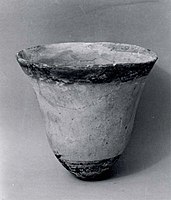

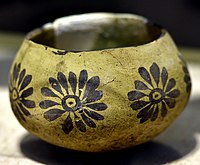



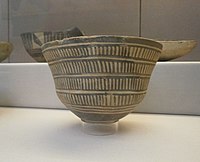
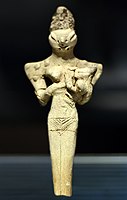




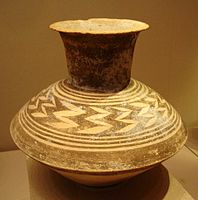

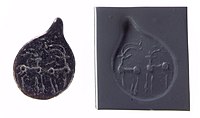
![Stamp seal with Master of Animals motif; c. 4000 BC; Tell Tello; Louvre Museum AO 15388[37][38][39]](http://upload.wikimedia.org/wikipedia/commons/thumb/b/b6/Stamp_seal_with_Master_of_Animals_motif%2C_Tello%2C_ancient_Girsu%2C_End_of_Ubaid_period%2C_Louvre_Museum_AO14165_%28detail%29.jpg/193px-Stamp_seal_with_Master_of_Animals_motif%2C_Tello%2C_ancient_Girsu%2C_End_of_Ubaid_period%2C_Louvre_Museum_AO14165_%28detail%29.jpg)